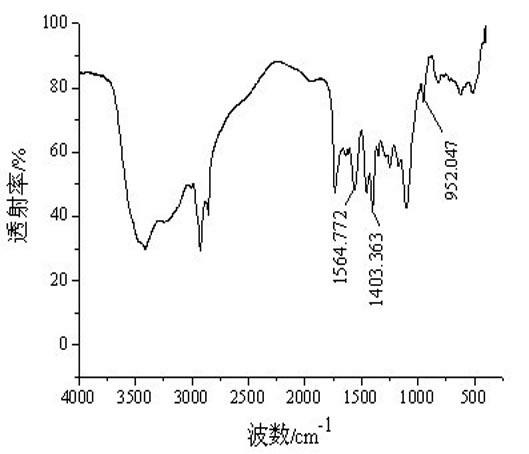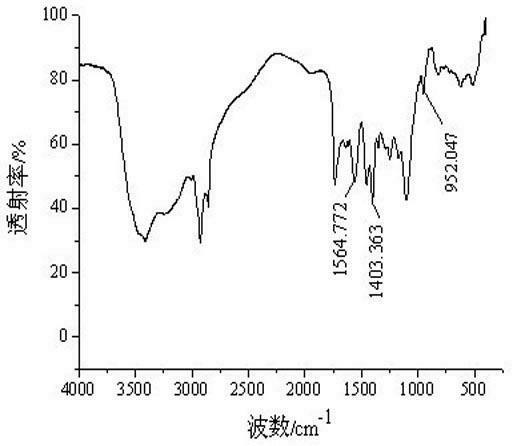Salt-resistive thickening agent as well as preparation method and application thereof
A thickener and salt-tolerant technology, which is applied in the field of salt-tolerant thickeners, can solve problems such as the influence of salt-resistant performance, the effect of association effects, and the difficulty of uniform copolymerization, so as to achieve stable salt-resistant performance, easy control, and high The effect of cost performance
- Summary
- Abstract
- Description
- Claims
- Application Information
AI Technical Summary
Problems solved by technology
Method used
Image
Examples
Embodiment 1
[0024] Add 60g of acrylic acid and 0.6g of N,N-methylenebisacrylamide into the reaction vessel, neutralize with ammonia water until the pH value of the mixture is 6.8; weigh 40g of kerosene and 5.0g of Span-80, and mix the two After fully mixing, slowly add the mixed solution neutralized by acrylic acid, 5.4g of salt-tolerant monomer (A) and 0.18g of ammonium persulfate. The general structural formula of salt-tolerant monomer (A) is:
[0025] ,
[0026] Wherein, R is n-dodecyl, and the degree of polymerization n is 20.
[0027] After stirring at a speed of 1800 rpm, fully emulsified into a viscous liquid, change to a stirring speed of 90 rpm, blow nitrogen, heat, control the temperature at 60 ° C for 2.5 hours, cool to room temperature, add and 5.0g Tween-80, stirring at a speed of 1200 rpm for 35 minutes to obtain a salt-tolerant thickener.
[0028] See attached figure 1 , which is the infrared spectrogram of the salt-tolerant thickener prepared in the present embodiment...
Embodiment 2
[0030] Add 60g of acrylic acid and 0.72g of N,N-methylenebisacrylamide into the reaction vessel, neutralize with sodium hydroxide solution until the pH of the mixture is 6.5; then weigh 36g of odorless kerosene and 3.6g of Span-80 After fully mixing the two, slowly add the mixed solution after neutralization of acrylic acid, 4.8g of salt-tolerant monomer (A) and 0.12g of sodium persulfate. The general structural formula of salt-tolerant monomer (A) is:
[0031] ,
[0032] Among them, R is n-hexadecyl, and the degree of polymerization n is 30; after being stirred at a speed of 1500 rpm and fully emulsified into a viscous liquid, the stirring speed is changed to 80 rpm, nitrogen gas is passed, heating is carried out, and the temperature is controlled. After reacting at 55° C. for 3 hours, cool down to room temperature, add 3.6 g of Tween-80, and stir at 1300 rpm for 30 minutes to obtain a salt-tolerant thickener.
Embodiment 3
[0034]Add 60g of acrylic acid and 0.9g of N,N-methylenebisacrylamide into the reaction vessel, neutralize with sodium hydroxide solution until the pH value of the mixture is 7.0; then weigh 42g of kerosene and 6.3g of Span-80, After fully mixing the two, slowly add the mixed solution after neutralization of acrylic acid, 6.0g of salt-tolerant monomer (A) and 0.24g of potassium persulfate. The general structural formula of salt-tolerant monomer (A) is:
[0035] ,
[0036] Among them, R is n-octadecyl, and the degree of polymerization n is 40; after being stirred at a speed of 2000 rpm and fully emulsified into a viscous liquid, the stirring speed is changed to 120 rpm, nitrogen gas is passed, heating is carried out, and the temperature is controlled. After reacting at 65° C. for 2.8 hours, cool down to room temperature, add 6.3 g of Tween-80, and stir at a speed of 1500 rpm for 32 minutes to obtain a salt-tolerant thickener.
PUM
 Login to View More
Login to View More Abstract
Description
Claims
Application Information
 Login to View More
Login to View More - R&D
- Intellectual Property
- Life Sciences
- Materials
- Tech Scout
- Unparalleled Data Quality
- Higher Quality Content
- 60% Fewer Hallucinations
Browse by: Latest US Patents, China's latest patents, Technical Efficacy Thesaurus, Application Domain, Technology Topic, Popular Technical Reports.
© 2025 PatSnap. All rights reserved.Legal|Privacy policy|Modern Slavery Act Transparency Statement|Sitemap|About US| Contact US: help@patsnap.com



